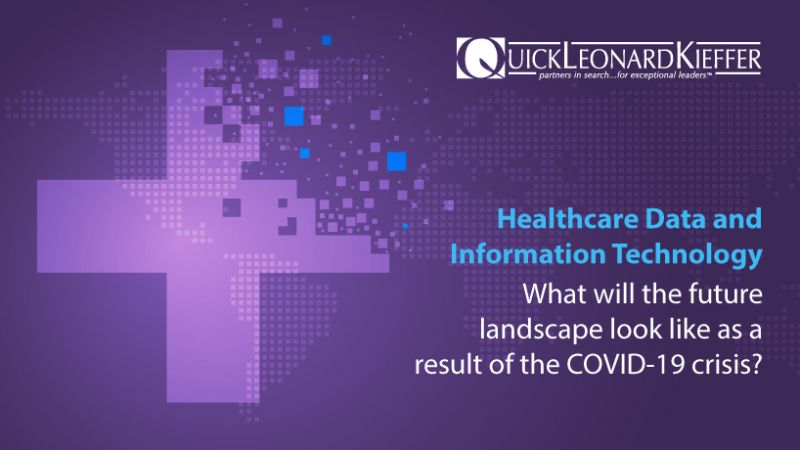Quick Leonard Kieffer is fortunate to have Steve Lieber on its team as Of Counsel. With a long tenure of leadership in healthcare data and information management, innovation, and policy, Steve discusses the current state of healthcare data and IT, as well as what he anticipates the future landscape will look like as a result of the COVID‐19 crisis.
Current Challenges
The Great Recession of 2008/2009 impacted health care for a very short time, as health care is an industry that is often largely immune to general changes in the economy. By contrast, COVID‐19 has understandably had a significant negative impact on the industry, particularly on public hospitals that serve as safety net facilities, although all acute care settings are faced with the loss of revenue from elective procedures and routine visits. The provider world today, in many cases, is simply trying to keep its head above water; that is true with regard to technology and information systems, as well as clinically. Existing systems and resources are stretched on a daily basis, resulting in a strong focus on ensuring that systems are running and that technology resources – medical devices (e.g. ventilators, respirators, and monitors) as well as information systems – are available to support caregivers, keeping the technology and IS areas of provider organizations extremely busy. Although the CARES Act will provide $100 billion in relief funds to hospitals and other healthcare providers on the front lines of the coronavirus response to help address lost revenue, some hospitals may be challenged to the point of facing closure, while all will certainly be faced with the challenge of having sufficient resources to invest in technology.
Changes in the Air
Changes in the delivery of care are already occurring, and there is no doubt in my mind that a positive consequence of the pandemic is that it has pushed us to recognize in a very blatant way something that has been on the periphery for some time – that remote care and monitoring are viable substitutes for some care occurrences that previously took place in a doctor’s office or hospital. Regulations have changed, reimbursement is changing, and providers are more widely accepting the concept of telehealth. The Amwell telehealth platform has seen usage of its app increase by 158% since January, with a 650% increase in the state of Washington, according to Quartz. (The challenge with routine care being provided through telehealth, however, is that a significant portion of the population does not have a primary care physician, as underinsured and uninsured patients are often able to receive care only by going to an emergency department where they cannot be refused.)
An increase in remote visits and monitoring will necessitate increased technology investment in three areas – at the provider site, at the patient site, and in connectivity between the two. The devices that patients will have in their homes will not only proliferate in number, but will become more sophisticated, with the ability to accomplish diagnostic work by capturing data (e.g. blood oxygen, blood pressure, temperature, electrical activity of the heart) and transmitting it to the appropriate sites. Testing has been a significant issue with COVID‐19, and I foresee remote home testing also becoming more prevalent, with the capability to move beyond video chats to cameras that can be inserted into ears or throats to diagnose infection. The first home pregnancy test was patented in 1969, and I foresee many more such home‐ based tests for conditions that are not life‐threatening emerging. As there is increased complexity of the information being streamed, the consumption of bandwidth will increase and investment in internet infrastructure will be part of the changes we will see, as well.
Concierge medicine – personalized, “on call” medical services provided on a subscription basis – will likely also see an increase for a select population, providing immediate access to care for low‐level illnesses and injuries. Across the country, the “drive‐through” model has been employed as a new way of delivering care and testing. Although it is currently a necessity due to volume and contagion, lessons are being learned to potentially implement this in a planned environment in the future.
Unfortunately, in the current U.S. healthcare system, disadvantaged populations – whether economically or in terms of mental health challenges – tend to be left behind. The hope is that a crisis such as COVID‐ 19 will intensify the focus on public health issues rather than individual health issues, recognizing that the health of one segment of the population impacts that of everyone else. The discussion around population health has been taking place for a number of years as hospitals focus on it as an aspect of their community obligation, but it has largely been in the framework of insured patients.
Impact
We have learned that we do not have the human capacity in our healthcare system to absorb unprecedented spikes of whatever kind – the technology may be available, but a human must be available to receive and respond to the data coming in. Many industries are facing difficulty in keeping up with customer service as utilization has skyrocketed, and I expect that health care will experience the same.
There will also be an impact on capital thinking as this shift in care occurs, consistent with what we have seen over the past 20‐30 years as long inpatient stays have become short inpatient stays, then outpatient visits, and then urgent care visits. Some capital devoted to brick‐and‐mortar healthcare facilities will be shifted as volume decreases with the growth of remote care. Healthcare organizations with plans for facility expansion may put these plans on hold until it can be determined whether the impact will be dramatic enough to rethink new space and put resources elsewhere.
A non‐clinical impact that nonetheless draws in technology is supply chain. This infrastructure had evolved to one of maintaining a small on‐hand inventory with “just‐in‐time” delivery; however, shortages of supplies across the country for dealing with COVID‐19 may challenge this model, prompting a return to maintaining much larger supplies in‐house. Technology tools will be required to manage the supply chain and meet community expectations.
Interoperability
During the fallout from Hurricane Katrina, we heard very quickly – and very loudly – about the problems that resulted from not having electronic medical records in place. During COVID‐19, however, we are not hearing about challenges with patient data, as the focus is on immediate patient care. When we emerge, I believe that there will be more conversations about these issues, as the importance of having information flow between the medical group practices, the outpatient clinics, the ED, and the hospital is recognized. When data is analyzed, I think some disturbing results will emerge in terms of a lack of data hindering care; however, this must take a back seat to the immediate medical crisis.
A majority of COVID‐19 deaths have occurred among adults older than 60 years and individuals with serious underlying health conditions. A greater sensitivity has, therefore, developed to protecting those most at risk, which goes hand in hand with the need to identify risk early on through testing. We are likely to see a strong emphasis on recognizing, identifying, and tracking those most at risk, as well as those who are likely to be sources of infection. We will see a significant change in our capacity for earlier detection, isolation, and protection of those at risk, reminiscent of the mass inoculation that occurred after a polio vaccine was developed in the 1950s.
A Healthcare CIO’s Go‐Forward Strategy
As a healthcare CIO exiting the COVID‐19 crisis, my first task would be to perform an internal assessment and debriefing; in essence, grading myself and my IT organization on how we handled the demand with our existing technology and systems, addressing what worked and did not and any weaknesses that might have been uncovered in dealing with a crisis. It is not necessarily possible to be ready for a crisis of this magnitude to occur 24/7, 365 days a year, and no one yet knows what the metric will be that healthcare systems will use in planning; however, we can make sure that our existing plant and resources are working and are suitable for something “above normal.” We will not return to past state and forgo concern about these situations happening again; as a result, some IT strategic planning to assess routine technology resources and how they would fare will be in order.
Secondly, I would reassess emergency preparedness based on probabilities to determine what would be done and what should be built for. What could we have done or had in place to make dealing with COVID‐ 19 easier? This leads to diving into in‐house resources that are available but not routinely used – capacities that could be brought in as needed – including medical equipment.
Third is reassessing the organization’s external role and resources in the community – seeking how to expand capability in serving the community without patients coming to the campus, which necessitates creating the right kinds of technology relationships with primary care. When assisted living facilities and nursing homes are part of a health system, they provide an ideal environment for remote monitoring, as their patients are long‐term, and acute care CIOs can employ technology to support those caregivers in the care processes and to bring adult children into the loop.
An additional area of exploration for a hospital or health system CIO would be opportunities to serve as a technology provider. Several clients of Quick Leonard Kieffer operate as resources to other healthcare organizations in the community through a centralized IT structure – selling technical expertise to the broader community is a role I believe will emerge in the future for IT leadership in the large provider setting.
CIOs will also be faced with more actively engaging and driving consumers to utilize technology at home. Providers will need to create incentives for consumers to have the right equipment to support the new model of more sophisticated at‐home care. Incentives will also be required for primary care physicians to drive utilization in better connecting to patients without a disruption in care, both from an appropriateness of care position and a revenue position. From the clinical and financial perspectives, there are things to be done to drive greater engagement between patient, primary care, medical groups, and the enterprise trying to pull all of this together.

Steve is an internationally recognized association and healthcare leader with 35 years of leadership experience. He is a frequent commentator on health policy, in general, and healthcare IT trends and issues, specifically – a regular speaker and contributor to health system and corporate strategic planning efforts, government‐sponsored policy efforts, private sector initiatives, and other non‐profit organizations and associations. Steve has been consistently recognized as one of Modern Healthcare’s “100 Most Influential People in Health Care”; in 2017, he was recognized as “Professional Association CEO of the Year” by CEO Update for his remarkable leadership of the Healthcare Information and Management Systems Society (HIMSS), and in 2015, he received the Samuel Shapiro Association Executive of the Year Award from Association Forum.
Prior to joining QLK, Steve spent 17 years as the president and CEO of HIMSS, the leading global, cause‐ based, not‐for‐profit organization focused on better health through information and technology. In this strategic role, Steve orchestrated the organization’s expansion in scope and reach to more than 40 countries. Earlier in his career, Steve served as the CEO of the Emergency Nurses Association; vice president of the American Hospital Association’s (AHA) Division of Personal Membership Groups; vice president of operations for the Illinois Hospital Association (IHA); senior budget analyst for the Illinois Bureau of the Budget; and assistant administrator for research and statistics with Arkansas Social Services. He earned his bachelor’s degree in psychology from the University of Arkansas and his master’s degree in social service administration from the University of Chicago.
Steve has been a Certified Association Executive since 1994, is a member of the American Society of Association Executives and Association Forum, and has been awarded honorary life memberships with the American Hospital Association and the American Society of Healthcare Risk Management. He was one of the founders of the Certification Commission for Health Information Technology (HIT) and the HIT Technology Standards Panel, two federally funded initiatives at the foundation of the U.S. interoperability effort.


